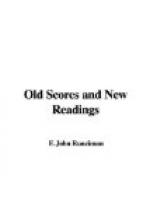The precise provocation of this essay was a certain performance of “Lohengrin.” During the first act the drama proceeded with charming, almost Mozartean, smoothness; and I was surprised to find that the smoother it went the more irresistibly the music reminded me of Weber, until I remembered that “Lohengrin” is Wagner’s most Weberish opera, and that in his youth Wagner heard Weber sung, not as he is sung now—that is, like an early Wagner music-drama—but as Weber intended it to be sung, like a later Mozart opera. For Weber stood very near to Mozart, modern as he often seems. He was born before Mozart died; he worshipped him, and absolutely refused to speak to Salieri because Salieri had been Mozart’s enemy; and it is easy to see, when once we rid ourselves of the idea that he was a rudimentary music-dramatist, that in his music he adhered as closely to Mozartean simplicity as his very different genius would permit. Perhaps, after all, it is his greatest glory that he is the connecting link between Mozart and Wagner, between the greatest composer born into the eighteenth century and the greatest born into the nineteenth; for the musical-pictorial art which he evolved from Mozart’s technique was used by Wagner with only the slightest modifications in the making of his music-dramas. But whereas Weber was a factor in the Romantic movement when it was most magnificently unreasonable, Wagner came later, and, though he felt the force of the current, it did not carry him into the absurdities that weaken—for they do weaken—much of Weber’s work. Wagner has been described as Weber, as Weber might have become; but the truth is that he was Weber’s younger brother, who took Weber’s art and used it to nobler ends with a degree of intellect, dramatic power, invention, and passion which Weber did not possess. To Weber the scenery was the important thing, and humanity almost seemed to be dragged in because the human voice was indispensable; but Wagner, going back to Mozart, restored humanity to its proper place, thus making his opera into real drama, and kept the fantastic creatures who haunted Weber’s woods and glens and streams only as emblems of the natural forces that war for or against humanity. Above all, he got rid of Weber’s stage villains—for Samiel is merely the stage villain of commerce; and, instead of the dusk and shadow in which Weber’s fancy loved to roam, he gives us sunlight and the sweet air. “Lohengrin” is full of




